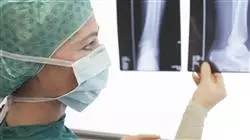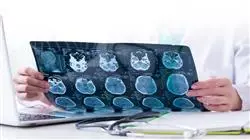University certificate
Scientific endorser

The world's largest faculty of nursing”
Introduction to the Program
Through this Postgraduate Diploma, based on Relearning, you will have a robust knowledge of traumatic bone injuries and the most sophisticated imaging techniques for their evaluation"

The analysis of firearm injuries constitutes one of the most important areas in the field of Forensic Radiology. Despite the benefits of technologies such as Computed Axial Tomography, the identification and study of explosive fragments remains a challenge for professionals. In this regard, nurses provide important logistical support during radiological procedures by being in charge of moving the mortal remains. In this way, they ensure that the images to be obtained are distinguished by both their accuracy and quality. The images help to ensure that details of bone and soft-tissue injuries are reflected in the snapshots to help determine the cause of death.
From this perspective, TECH is developing a pioneering Postgraduate Diploma in Forensic Radiology in Bone Trauma for nurses who wish to optimize their clinical practice and develop advanced skills for the care of people who have suffered such injuries. The academic itinerary will focus on the analysis of radiological techniques in both bone and dental fractures, thus examining the most commonly used elements of blunt injuries (including sharp-edged and firearms). The program will also provide graduates with the most innovative radiological techniques for the study of different injuries. In this way, they will have an integral vision of the use of tools such as X-Rays, Magnetic Resonance Imaging or Computed Axial Tomography. Additionally, during the academic pathway they will acquire advanced interdisciplinary skills to foster a comprehensive assessment of bone trauma in forensic cases.
Regarding the methodology of the university program, TECH is based on the innovative Relearningteaching system. Based on the natural repetition of fundamental ideas, this method will ensure that graduates enjoy effective and progressive learning.
You will have numerous clinical case studies that will increase your technical skills in the management of human bodies with total amputation injuries"
This Postgraduate Diploma in Forensic Radiology in Bone Trauma contains the most complete and up-to-date scientific program on the market. The most important features include:
- The development of practical cases presented by experts in Forensic Radiology
- The graphic, schematic and eminently practical contents with which it is conceived gather scientific and practical information on those disciplines that are indispensable for professional practice
- Practical exercises where the self-assessment process can be carried out to improve learning
- Its special emphasis on innovative methodologies
- Theoretical lessons, questions to the expert, debate forums on controversial topics, and individual reflection assignments
- Content that is accessible from any fixed or portable device with an Internet connection
You will delve into Virtual Autopsy in deaths caused by firearm projectiles and provide more specialized care to individuals who have suffered these types of injuries"
The program’s teaching staff includes professionals from the field who contribute their work experience to this educational program, as well as renowned specialists from leading societies and prestigious universities.
The multimedia content, developed with the latest educational technology, will provide the professional with situated and contextual learning, i.e., a simulated environment that will provide immersive education programmed to learn in real situations.
This program is designed around Problem-Based Learning, whereby the professional must try to solve the different professional practice situations that arise during the course. For this purpose, students will be assisted by an innovative interactive video system created by renowned and experienced experts.
You will have a multimedia library that will strengthen your learning in a dynamic way, including interactive summaries of each module"

TECH offers you a 100% online university program, adapting to your needs and making it easier for you to complete it while you carry out your full-time healthcare activity"
Why study at TECH?
TECH is the world’s largest online university. With an impressive catalog of more than 14,000 university programs available in 11 languages, it is positioned as a leader in employability, with a 99% job placement rate. In addition, it relies on an enormous faculty of more than 6,000 professors of the highest international renown.

Study at the world's largest online university and guarantee your professional success. The future starts at TECH”
The world’s best online university according to FORBES
The prestigious Forbes magazine, specialized in business and finance, has highlighted TECH as “the world's best online university” This is what they have recently stated in an article in their digital edition in which they echo the success story of this institution, “thanks to the academic offer it provides, the selection of its teaching staff, and an innovative learning method aimed at educating the professionals of the future”
A revolutionary study method, a cutting-edge faculty and a practical focus: the key to TECH's success.
The most complete study plans on the university scene
TECH offers the most complete study plans on the university scene, with syllabuses that cover fundamental concepts and, at the same time, the main scientific advances in their specific scientific areas. In addition, these programs are continuously being updated to guarantee students the academic vanguard and the most in-demand professional skills. In this way, the university's qualifications provide its graduates with a significant advantage to propel their careers to success.
TECH offers the most comprehensive and intensive study plans on the current university scene.
A world-class teaching staff
TECH's teaching staff is made up of more than 6,000 professors with the highest international recognition. Professors, researchers and top executives of multinational companies, including Isaiah Covington, performance coach of the Boston Celtics; Magda Romanska, principal investigator at Harvard MetaLAB; Ignacio Wistumba, chairman of the department of translational molecular pathology at MD Anderson Cancer Center; and D.W. Pine, creative director of TIME magazine, among others.
Internationally renowned experts, specialized in different branches of Health, Technology, Communication and Business, form part of the TECH faculty.
A unique learning method
TECH is the first university to use Relearning in all its programs. It is the best online learning methodology, accredited with international teaching quality certifications, provided by prestigious educational agencies. In addition, this disruptive educational model is complemented with the “Case Method”, thereby setting up a unique online teaching strategy. Innovative teaching resources are also implemented, including detailed videos, infographics and interactive summaries.
TECH combines Relearning and the Case Method in all its university programs to guarantee excellent theoretical and practical learning, studying whenever and wherever you want.
The world's largest online university
TECH is the world’s largest online university. We are the largest educational institution, with the best and widest online educational catalog, one hundred percent online and covering the vast majority of areas of knowledge. We offer a large selection of our own degrees and accredited online undergraduate and postgraduate degrees. In total, more than 14,000 university degrees, in eleven different languages, make us the largest educational largest in the world.
TECH has the world's most extensive catalog of academic and official programs, available in more than 11 languages.
Google Premier Partner
The American technology giant has awarded TECH the Google Google Premier Partner badge. This award, which is only available to 3% of the world's companies, highlights the efficient, flexible and tailored experience that this university provides to students. The recognition as a Google Premier Partner not only accredits the maximum rigor, performance and investment in TECH's digital infrastructures, but also places this university as one of the world's leading technology companies.
Google has positioned TECH in the top 3% of the world's most important technology companies by awarding it its Google Premier Partner badge.
The official online university of the NBA
TECH is the official online university of the NBA. Thanks to our agreement with the biggest league in basketball, we offer our students exclusive university programs, as well as a wide variety of educational resources focused on the business of the league and other areas of the sports industry. Each program is made up of a uniquely designed syllabus and features exceptional guest hosts: professionals with a distinguished sports background who will offer their expertise on the most relevant topics.
TECH has been selected by the NBA, the world's top basketball league, as its official online university.
The top-rated university by its students
Students have positioned TECH as the world's top-rated university on the main review websites, with a highest rating of 4.9 out of 5, obtained from more than 1,000 reviews. These results consolidate TECH as the benchmark university institution at an international level, reflecting the excellence and positive impact of its educational model.” reflecting the excellence and positive impact of its educational model.”
TECH is the world’s top-rated university by its students.
Leaders in employability
TECH has managed to become the leading university in employability. 99% of its students obtain jobs in the academic field they have studied, within one year of completing any of the university's programs. A similar number achieve immediate career enhancement. All this thanks to a study methodology that bases its effectiveness on the acquisition of practical skills, which are absolutely necessary for professional development.
99% of TECH graduates find a job within a year of completing their studies.
Postgraduate Diploma in Forensic Radiology in Bone Trauma
At TECH Global University, we are pleased to introduce you to our innovative Postgraduate Diploma in Forensic Radiology in Bone Trauma, designed especially for nursing professionals seeking to expand their knowledge and skills in the fascinating field of forensic radiology. Our program combines academic rigor with the flexibility of online classes, allowing you to access high-quality training from anywhere and at any time that fits your professional and personal schedule. At TECH, we understand that constant updating is essential in a field as dynamic as forensic nursing, which is why this postgraduate program focuses on providing you with the most advanced knowledge and tools to excel in your career. Upon successful completion of our program you will be prepared to perform with excellence in a variety of forensic settings, including hospitals, forensic laboratories, law enforcement agencies and more.
Obtain a qualification in forensic radiology
Why choose us? First of all, our institution stands out for its commitment to academic excellence and educational innovation. We have a team of highly qualified faculty members who are experts in the field of forensic radiology, who will guide you throughout your learning process and provide you with the necessary support to achieve your professional goals. In addition, our syllabus has been carefully designed to cover all relevant aspects of forensic radiology in bone trauma, from the theoretical fundamentals to the techniques of medical image analysis and interpretation. Through case studies, real-world case studies and simulations, you will have the opportunity to apply your knowledge in real-world situations, strengthening your ability to meet the challenges of the field. Take the opportunity to give a decisive boost to your professional career and become a reference in the field of forensic radiology. Enroll today in our 100% online postgraduate program and take the first step towards a future full of success and opportunities!







